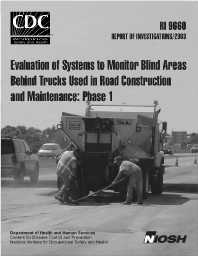Mining Publication: Evaluation of Systems to Monitor Blind Areas Behind Trucks Used in Road Construction and Maintenance: Phase 1
Original creation date: February 2003
The majority of fatalities that occur in road construction work zones in the United States involve a worker being struck by a piece of construction equipment or other vehicle. The Spokane Research Laboratory of the National Institute for Occupational Safety and Health, in cooperation with the Washington State Department of Transportation, is evaluating methods to decrease these accidents. One such method uses devices that assist equipment operators in monitoring blind areas around the equipment to prevent collisions with workers on foot or other objects. Several cameras and sensor systems are available for this application, and a study was conducted to evaluate these systems on various trucks used in road construction and maintenance. Tests were conducted using sanding trucks during the winter months, which allowed researchers to investigate the effectiveness and limitations of various technologies under the most extreme conditions. Tests were also conducted using dump trucks during the warmer months to study the effectiveness of the systems in highway work zones. Results show that many difficulties arise when using camera and sensor systems in cold, snowy climates. And, while the operation of these systems is more reliable during the warmer months, challenges still exist in using them on equipment in crowded work areas.
Authors: TM Ruff
Report of Investigations - February 2003
NIOSHTIC2 Number: 20022549
U.S. Department of Health and Human Services, Public Health Service, Centers for Disease Control and Prevention, National Institute for Occupational Safety and Health, DHHS (NIOSH) Publication No. 2003-113, Report of Investigations 9660, 2003 Feb; :1-15
See Also
- Analyzing Factors Influencing Struck-by Accidents of a Moving Mining Machine by Using Motion Capture and DHM Simulations
- Analyzing Factors Influencing Struck-By Accidents of a Moving Mining Machine by Using Motion Capture and DHM Simulations
- Characteristics of Fugitive Dust Generated from Unpaved Mine Haulage Roads
- Continuous Mining: A Pilot Study of the Role of Visual Attention Locations and Work Position in Underground Coal Mines
- Crewstation Analysis Programs - An Easy to Use Personal Computer-based Lighting and Visibility Analysis Software Package for Underground Mining Equipment
- Evaluation of Peripheral Visual Performance When Using Incandescent and LED Miner Cap Lamps
- Preventing Collisions Involving Surface Mining Equipment: A GPS-based Approach
- A Simulation Approach Analyzing Random Motion Events Between a Machine and its Operator
- Test Results of Collision Warning Systems for Surface Mining Dump Trucks
- Visual Performance for Incandescent and Solid-State Cap Lamps in an Underground Mining Environment
- Content source: National Institute for Occupational Safety and Health, Mining Program


 ShareCompartir
ShareCompartir
